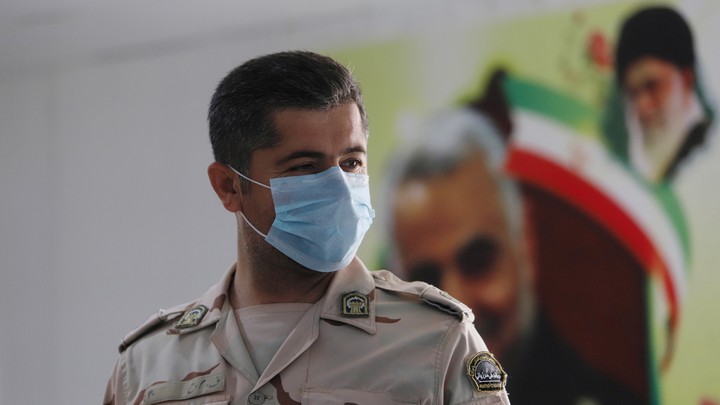
Iran Has Far More Coronavirus Cases Than It Is Letting On
The surprising number of Iranian government officials succumbing to COVID-19 offers a hint that the disease is far more widespread than the official statistics indicate.
Graeme Wood
You are standing before a huge barrel of apples. You can’t see the apples, but you can reach in and pick them out. Most are delicious, but a very small number of them are rotten—just about one in 12,000, your friend assures you. You reach in blindly and miraculously pick out a rotten apple. You reach in again and withdraw a whole heaping bushel of apples, maybe 50 in all. Most are good, but when you look closely you see them: one, two, three, four more rotten apples. One rotten apple is an amazing coincidence. Five means your barrel has lots of rotting apples in it and your friend was lying to you.
As of yesterday, according to Johns Hopkins University’s Coronavirus Resource Center, Iran has reported 6,566 COVID-19 cases, or about one in every 12,000 people in its population. The first case appeared on February 19. Right now Iran is third behind China (80,695) and South Korea (7,314), and just ahead of Italy (5,883). But the official Iranian number is almost certainly an undercount, probably due to the Iranian government’s attempt to hide a desperate situation for which it is partially responsible. When the final history of the coronavirus epidemic of 2020 is written, it may go something like this: The disease started in China, but it became finally and irrevocably uncontained in Iran. Knowing that the Iranian number is much higher than currently disclosed tells the rest of the world that the epidemic is even further along than official statistics indicate.
The first sign of dishonesty came on February 28, when Masoumeh Ebtekar, one of the country’s vice presidents, announced that she had the virus. Ebtekar is one of the most famous politicians in the country, well known even in the West for her role as a particularly sadistic member of the group that held U.S. diplomats hostage in 1979 in Tehran. Of course, being a notorious sociopath confers no immunity against COVID-19. But here is where the rotting apples come in.
If COVID-19 is so rare—fewer than 400 cases had been reported in Iran by the day she announced her diagnosis—what are the chances that one of the afflicted would be a famous politician? Soon we learned of three other senior officials who not only contracted the virus but were killed by it: Mohammad Mirmohammadi, a member of a senior advisory council to Iran's supreme leader, and Hossein Sheikholeslam and Hadi Khosrowshahi, both former high-level diplomats. Mohammad Sadr, another member of the council, announced his infection last week, as did Ebtekar’s fellow cabinet member Reza Rahmani. Recently, the speaker of parliament said 23 of his fellow members of parliament had tested positive. Two of them, Mohammad Ali Ramezani (February 29) and Fatemeh Rehber (March 7), have died.
That’s a lot of tainted apples, statistically speaking. Why would Iran lie? On February 21, Iran conducted the latest in a series of sham elections in which only government-selected candidates could run for office. To show disapproval, many Iranians refuse to vote, and as participation has dropped, the appearance of electoral legitimacy has dropped as well. Iran’s government told its people that the United States had hyped COVID-19 to suppress turnout, and Tehran vowed to punish anyone spreading rumors about a serious epidemic. Forty-three percent of Iranians voted, unaware that the outbreak had already begun. Quick action could have allowed quarantines to be put in place. Instead Iran greased its own path toward the most catastrophic outbreak in modern history.
Remember that the official number of cases is 6,566. Yet a variety of other indicators suggest that far more people in Iran have become infected:
- A paper by the University of Toronto’s Ashleigh Tuite and others noted that, by February 23, cases of Iranian origin had surfaced in Canada, Lebanon, and the United Arab Emirates. Given the volume of air travel between Iran and these countries, Tuite’s team estimated how many native COVID-19 cases must have occurred in Iran to produce one case each in these other countries. Their estimate for February 23: 18,300. Since the epidemic reached 100 cumulative cases, the official numbers have doubled roughly every three days. If that rate held, the estimate as of today would be 586,000.
- On March 3, 23 out of 290 members of parliament—about 7.9 percent—had the disease. (Unlike ordinary people, these MPs probably had reliable access to diagnosis. State media insisted they contracted the disease not from one another, but from their home districts.) The rate of infection of parliamentarians would, if applied to Iran’s total population, come to 6.4 million cases.
- Let’s consider the other politicians. The senior advisory council has experienced two known deaths out of 39 members; the cabinet has two known infections out of 30. Even if no other council or cabinet members had COVID-19, that’s an infection rate of 5.8 percent. That would mean an estimate of 4.7 million.
- A government website invited Iranians to submit details of symptoms they were experiencing. After 2 million responses, about 9 percent reported COVID-19 symptoms. In the United States, among those whose symptoms and history have led them to be tested for COVID-19, about 10 percent have eventually tested positive. If that rate holds, Iran would have 730,000 cases.
- On March 4 and 5, two evacuation flights of Chinese citizens were allowed to leave Tehran for China’s Gansu province. Chinese authorities were of course wary of introducing more coronavirus carriers into the country, so they tested passengers and found 11 COVID-19 cases out of 311 passengers. If Chinese people in Iran got the disease at the same rate as Iranians, that suggests a rate of 3.5 percent, for a total of 5.7 million at the time of the flight. Tuite, the researcher who studied earlier flights, cautions that this number would undercount total cases, because it represents the number of cases on that plane at that time (the “point prevalence”) and not total cumulative cases—which would be higher, about 8 million. “It’s alarming, and I have a hard time wrapping my head around the implications of this,” she told me. “But I think it’s possible.”
- Seven of the 21 COVID-19 patients in British Columbia had traveled recently in Iran. Finding a denominator for this number is difficult, but we can try. British Columbia has about 50,000 Iranian Canadians, and let’s assume they visit Iran, say, once every four years on average and stay for a month. That means in any given month, about 1,000 return from Iran. That suggests a total COVID-19 burden of 590,000 cases.
- On March 8, health authorities in Golestan province declared that hospitals there were full. Golestan has about 2.2 percent of Iran’s population, and if we assume it has the same percentage of its hospital beds, the province should have 2,600 hospital beds. Let’s assume that at least some people with other conditions are already in those beds and that roughly 2,000 beds are now filled with COVID-19 patients. About 15 percent of COVID-19 patients need a hospital stay. That suggests that 13,000 people—or about 0.8 percent of the province’s population—have COVID-19 in Golestan. If that rate applies countrywide, it yields 610,000 infections, which suggests a cumulative total of about 1 million infections—if we include those who have already recovered. Finally, because hospitalizations are a lagging indicator, double that number to account for growth in the past week: 2 million.
The average of these estimates is about 2 million, which is about 250 times the official number and 15 times the total cases acknowledged worldwide. According to models, Tuite told me, the point-prevalence of COVID-19 in Canada could rise to 5 to 10 percent of the total population when the epidemic reaches its peak. These numbers, which I have shown to experts, suggest that Iran might be at or near that point.
Does Iran really have 2 million citizens with COVID-19? Perhaps politicians spend more time in public, and are therefore more susceptible to infection; if so, some of the estimates above would overstate the number of cases. Then again, it’s also possible that they were aware of the epidemic earlier and took precautions. In that case, those estimates would understate the number of cases. Edward Kaplan, who studies epidemics at Yale, looked at my numbers and noted that many of Iran’s politicians are old men—the average age of senior advisory council members is 70—who are therefore especially likely to show symptoms of COVID-19, leading to a higher share of sufferers in political circles than in the general population. It’s also possible—perhaps likely—that these numbers over-sample for Tehran and Qom, both cities hammered by the epidemic. COVID-19 is in every Iranian province, but some provinces are earlier in their cycle than others.
Many similar unknowns make these estimates difficult to assess—which is why experts have to attack the problem from multiple angles, with the assumption that errors in one approach do not correlate to errors in the others, and get rounded out in the average. Even if the estimates are off by a lot, they still reveal an outbreak completely out of control, beyond the capacity of Iran or perhaps any country to manage.
The messages coming out of Iran on social media, especially from health-care workers, do little to convince me that my doomsday figures are inaccurate. David N. Fisman, a colleague of Tuite’s at the University of Toronto, notes that the virus reportedly spread after panicked residents of Qom and Tehran fled to smaller cities, thereby sowing COVID-19 all over the country. Circulating on social media are reports that some provinces, such as Mazandaran, have set up roadblocks to keep more people with the infection from spilling into their territory.
The situation the doctors describe is desperate, with nurses wrapping themselves in tablecloths because they have long since run through their supply of proper gear. They swear that the official numbers are wrong. “Just stay overnight in the hospital to find out what I'm talking about,” one wrote. Or if you want to live, go home, and don’t come out until the plague passes. “[Our] society now needs fear more than hope.”
Graeme Wood is a staff writer at The Atlantic and the author of The Way of the Strangers: Encounters With the Islamic State.
Source: theatlantic.com
Farsi translation:



